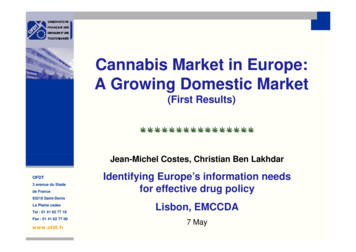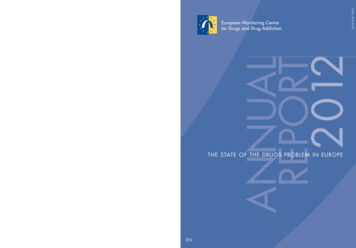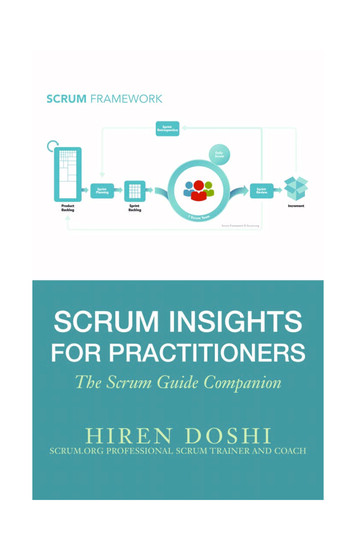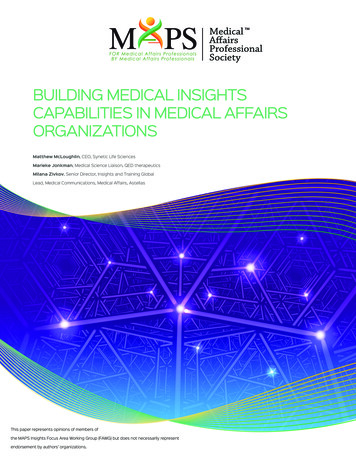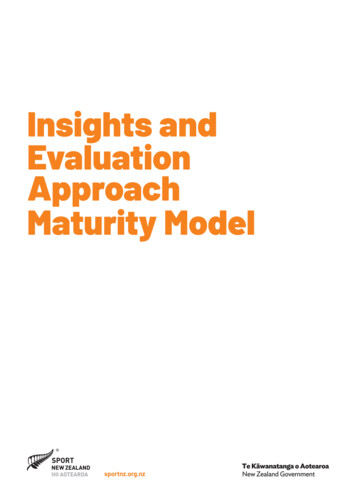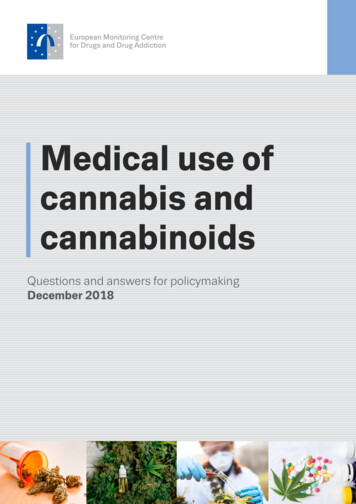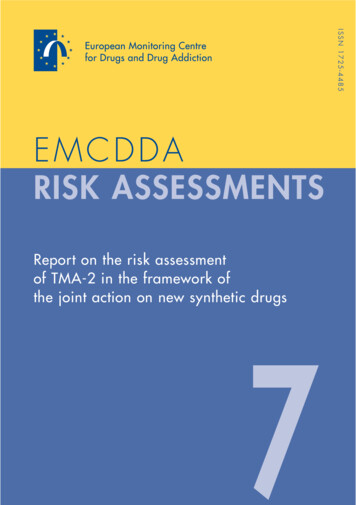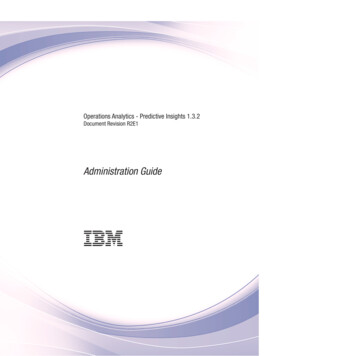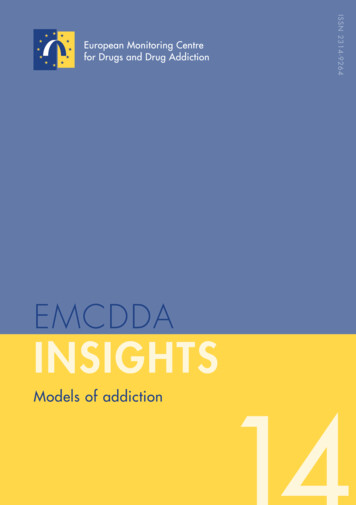
Transcription
IS S NIS2314S N 0000-0926 4 0 0 0INSIGHTSEMCDDAModels of addiction
EMCDDAINSIGHTSModels of addictionAuthorRobert West14
Legal noticeThis publication of the European Monitoring Centre for Drugs and Drug Addiction (EMCDDA)is protected by copyright. The EMCDDA accepts no responsibility or liability for anyconsequences arising from the use of the data contained in this document. The contents of thispublication do not necessarily reflect the official opinions of the EMCDDA’s partners, any EUMember State or any agency or institution of the European Union.Information on the European Union is available on the Internet. It can be accessed through theEuropa server (http://europa.eu).Europe Direct is a service to help you find answers to your questions about the European Union.Freephone number (*):00 800 6 7 8 9 10 11(*) Certain mobile telephone operators do not allow access to 00 800 numbers or these calls may be billed.Cataloguing data can be found at the end of this publication.Luxembourg: Publications Office of the European Union, 2013ISBN: 978-92-9168-652-0doi: 10.2810/99994 European Monitoring Centre for Drugs and Drug Addiction, 2013Reproduction of this publication is authorised provided the source is acknowledged.Printed in SpainPrintedon white chlorine-free paperCais do Sodré, 1249-289 Lisbon, PortugalTel. (351) 211 21 02 00 Fax (351) 218 13 17 11info@emcdda.europa.eu www.emcdda.europa.eu
ContentsForeword5Acknowledgements9Executive summary11Chapter 1: Background, scope and aims17Chapter 2: Defining addiction21Chapter 3: Summarising theories and models ofaddiction—methods29Chapter 4: Modelling in the individual33Chapter 5: Modelling populations79Chapter 6: Towards a comprehensive theory of addiction87Chapter 7: Implications of theory for assessment andmeasurement of addiction and related constructs105Chapter 8: Implications of the comprehensive theoryfor intervention strategies115Chapter 9: Implications for policy and practice127References1353
ForewordIt is a great pleasure to introduce this EMCDDA Insights publication on models andtheories of addiction. Addiction continues to be one of the key concepts in thescientific and policy debate around drug use and interventions, and lies at the veryheart of the responsibilities of this agency. The diverse approaches presented herehave been developed by different academic disciplines and are a reminder of thefact that addiction is a multifaceted problem. Without doubt, both understanding itand developing interventions to combat it will benefit from a broad perspective—onethat goes beyond the ‘brain disease’ model or purely sociological or economicapproach. With a view to encouraging debate, as well as a common understandingof this complex concept, this report presents a compendium of models of addictionplaced within an integrated framework.The EMCDDA commissioned this report in order to increase understanding of thenature of addiction, highlighting the lessons that alcohol, tobacco andnon-pharmacological addictions can provide for understanding addiction to illicitdrugs, and vice versa. The addiction concept is central to our work, and the variousmodels and theories are presented here against a background of recent debates inthe scientific community. While it is clear that drug problems are correlated with arange of factors, addiction is undoubtedly a central factor. It is also apparent that inmany ways addiction is a phenomenon that is not limited to illicit psychoactivesubstances, indeed, pharmacological agents. This discussion does not stop atsubstance-based problems and includes phenomena such as gambling or compulsiveuse of the Internet. We note that a number of European countries have establishedcentres of addiction that potentially cover the full range of addictive behaviours.One important conclusion is, therefore, that it is both possible and desirable toundertake a broader analysis of addictive behaviours than is currently practised.For those in the business of drug research and monitoring, it raises some centralquestions, such as whether we should continue to monitor addictive use by substanceor at a more general level.Importantly, this report progresses from a presentation of addiction theories to anexploration of their consequences for interventions. Utilising an integrativeframework, it is proposed that combating addiction requires an analysis of thecapabilities, opportunities and motivations needed for change in an individual ortarget population, followed by a selection of appropriate responses from a range of5
Models of addictioninterventions. Making use of this approach not only provides the reader with thepossibility of keeping an overview on the perspectives taken by the existing differentmodels of addiction, but also allows for the selection of policy and practiceinterventions based on the behavioural targets, and which in the long run, shouldenable the development of more effective response strategies.Wolfgang GötzDirector, EMCDDA6
AcknowledgementsThis publication was authored by Robert West from University College London. Theauthor is very grateful to Simon Christmas, an independent consultant, Susan Michiefrom University College London, Wayne Hall from the University of Queensland andRoland Simon from the EMCDDA for their helpful comments on the draft of thereport. He also thanks Sarah Dowling and Christopher Russell from UniversityCollege London for locating the appropriate references and for input to the draft ofthe report.9
Executive summaryAddiction is a global problem that costs many millions of lives each year and causesuntold suffering. It can involve ingesting licit and illicit psychoactive drugs (e.g.alcohol, nicotine, opioids, stimulants, steroids, prescription painkillers, sedatives orcannabis) or other kinds of activity (e.g. gambling, computer gaming). The scienceof addiction has advanced to a point at which it is timely to examine the wide rangeof underlying mechanisms that have been identified and assess what these imply forthe development of a comprehensive strategy for combating the problem. This reportreviews theories of addiction that have been proposed, with a view to generating anoverarching framework or model that captures all the main elements. It thenexamines how this model can be applied in assessment, prevention and treatment.The main conclusions are given below. The analysis and conclusions in this reportare offered as a framework for discussion.Definitions of addiction vary, but all involve the notion of repeated powerfulmotivation to engage in an activity with no survival value, acquired throughexperience with that activity, despite the harm or risk of harm it causes. Definitionsof addiction include ‘a primary, chronic disease of brain reward, motivation,memory and related circuitry reflected in the individual pursuing reward and/orrelief by substance use and other behaviours’ (American Society of AddictionMedicine) and ‘a condition of being abnormally dependent on some habit,especially compulsive dependency on narcotic drugs’ (www.thefreedictionary.com).Although these definitions do capture important features of addiction, they eitherfocus on just one aspect of it or use terms that cannot be interpreted clearly.Analysis suggests that the key features that definitions attempt to capture are thataddiction involves repeated powerful motivation to engage in an activity; it isacquired through engaging in the activity; the activity does not involve innateprogramming because of its survival value; and there is significant potential forunintended harm. This need not be limited to substance use or abuse.Numerous mechanisms underlying addiction have been discovered, and these havespawned a multitude of models, each of which addresses a part of the problem. Alarge number of models of addiction describing these mechanisms have beenproposed. The models are very heterogeneous and do not fall into a neathierarchical classification. However, for heuristic purposes they can be classified interms of whether they focus on individuals or populations. Those that focus on11
Models of addictionindividuals can be grouped into (1) those that focus on what has been termed‘automatic processing’ (associative learning, drives, inhibitory processes andimitation, none of which requires self-reflection and which can be investigated usingstudies with non-human animals) and (2) those that focus on reflective choiceprocesses (conscious decisions to behave in a particular way after a comparison ofthe costs and benefits), whether ‘rational’ (involving reason and analysis) or ‘biased’(subject to emotional or other processes that distort the decision-making process).Cutting across the automatic–reflective distinction are theories that (3) focus ondifferent types of goal (positive reward, acquired need and pre-existing need). Inaddition, there are (4) integrative theories that combine elements of automatic andreflective choice models, (5) theories that focus on change processes and (6)biological theories that describe the neural mechanisms thought to be involved inaddiction. Models that take a population perspective include (7) social networktheories, (8) economic models, (9) what might be termed communication/marketingmodels and (10) ‘systems’ models.An overarching model of behaviour (the COM-B model, which recognises thatbehaviour arises out of capability, opportunity and motivation) can be usefullyapplied to understanding addiction. It is evident from the research literature that anintegrated model merits consideration that can encompass the full range of conceptsin the above models. This would ideally recognise both the intra- and extraindividual factors involved and the interactions among them. An overarching modelof behaviour has been proposed that recognises that behaviour (B) arises from threenecessary conditions: capability (C), opportunity (O) and motivation (M). Such amodel could potentially address this need. The model would not be a replacementfor specific theories but rather provide a framework in which they could beunderstood and applied. Under this COM-B model, addiction could be viewed interms of the psychological and physical capabilities possessed by individuals (e.g.the capacity for self-regulation, the ability to learn from punishment, the ability toformulate and adhere to personal rules), opportunities afforded by the social andphysical environment (e.g. social and environmental cues, availability of alternativesources of reward, financial costs of the activity) and the competing motivationsoperating at relevant moments (e.g. need for emotional blunting, need forbelonging, anticipation of pleasure or satisfaction, anticipation of relief fromcraving, fear of disapproval). The motivations may be ‘reflective’ in the sense thatthey involve analysing the costs and benefits of a given course of action (e.g. thebelief that an activity is ‘wrong’ or ‘harmful’) or ‘automatic’ in the sense that they12
Executive summaryinvolve drives, emotional processing and habits (e.g. an intense feeling of the needto engage in an activity).The PRIME theory of motivation may provide a useful framework for understandingthe motivational aspects of addiction. It is an integrative model of motivation thatdescribes how ‘reflective’ and ‘automatic’ processes interact to control our behaviourand how these can promote addiction and recovery. Motivation is an importantcomponent of the COM-B model and consists of all the brain processes that energiseand direct behaviour. The PRIME theory of motivation integrates existing modelsincluding learning theory, decision theory, self-control theory, identity theory anddrive theory. It provides a framework for understanding how capability, opportunityand motivation interact and how the system as a whole can become disordered, asin the case of addiction.It is useful to distinguish factors that influence (1) initial enactment of the behaviour,(2) development of addiction, (3) attempts at recovery or mitigation and (4) relapse;however, there is also some commonality. Different factors have been found toinfluence the four phases of the addiction life cycle. These factors vary acrossdifferent cultural contexts and different individuals. There is also considerableoverlap in the factors that influence the different phases. This means that certaininterventions (e.g. population-level interventions to restrict access or increase thefinancial cost) can impact initiation, development, attempts at recovery fromaddiction and the success of those attempts.Population estimates of the prevalence of addiction based on diagnostic criteriapresent considerable challenges. Consideration should be given to estimates basedon the numbers of people engaging in a particular activity that is known to havesignificant addictive potential at a level which, in a population, involves significantharm. The multifaceted nature of addiction and involvement of intra-individual andenvironmental factors limits the value in seeking to determine the prevalence ofaddictions per se in populations. The resulting figures will vary substantially in termsof the thresholds of harm and strength or chronicity of motivation to engage in thebehaviours. For the purposes of assessing the extent of the problem and need forinterventions for different types of addiction, an alternative approach (and the onemost commonly used in practice) is to assess the number of people engaging in abehaviour which is known to have significant addictive potential at a level that, onaverage, will cause significant harm (e.g. the prevalence of any tobacco use oralcohol consumption above a risk threshold). Assessment of addiction in individuals13
Models of addictionand populations for the purposes of understanding and intervention could potentiallyinvolve all aspects of the COM-B system including capacity for self-regulation,environmental drivers, and wants and needs met by the addictive behaviour.A comprehensive framework for developing behaviour change interventions hasbeen developed that could potentially be used to develop an intervention strategy forcombating addiction. The COM-B model of behaviour has been linked to a systemfor developing an intervention strategy to achieve behaviour change. This identifieda set of nine intervention functions (education, persuasion, incentivisation, coercion,training, restriction, environmental restructuring, modelling and enablement) and asystem for selecting these on the basis of an analysis of what is driving the currentbehaviour and what is needed to achieve the new ‘behavioural target’. The initialselection of intervention functions then leads to identification of specific behaviourchange techniques (BCTs) that deliver these functions and policies (e.g. legislation,fiscal measures, service provision, communication/marketing) that enable them.Different intervention strategies might be needed for different addictive behaviours,different populations and individuals and different contexts. For example, if there isonly weak motivation to cease the activity because of lack of a true understanding ofthe harms, it may be sufficient to educate about those harms. In a situation in whichan individual’s behaviour is strongly under the control of immediate environmentaltriggers, environmental restructuring interventions may be appropriate. If anaddictive behaviour is being driven powerfully by the need to relieve or bluntemotional distress, then enabling interventions that provide an alternative source ofrelief may offer a solution. If an addiction is being driven largely by an acquiredself-perpetuating drive arising out of the pharmacological actions of a drug,recovery may be promoted by alternative medications such as partial agonists. Ingeneral, however, a multifaceted approach that addresses the system as a whole islikely to be needed.Multiple addictions and co-morbidities can arise from mutually interacting processeswithin any part of the COM-B system. The presence of more than one type ofaddiction concurrently, and the combination of addiction and other psychologicalproblems, can be viewed as arising from common aetiology in terms of capabilities,motivation and opportunities and from the way in which these interact with eachother. For example, child abuse, leading to low self-esteem, can have multiple effectsin terms of a lack of self-protective motives or even motives for self-harm as well asimpaired skills for self-regulation, a need for relief from depression or anxiety and14
Executive summaryengagement with a subculture that provides opportunities for particular kinds ofactivity including use of particular licit or illicit drugs depending on social and otherfactors. From such a perspective, an important starting point for prevention andtreatment would be to identify appropriate entry points into the COM-B system toachieve change that spreads throughout the system.Conclusions. The diverse models of addiction reflect the fact that it is a multifacetedproblem. Understanding it and developing interventions to combat it may benefitfrom a broad perspective that goes beyond the ‘brain disease’ approach or purelysociological or economic approaches. One way to bring these approaches togetheris to understand behaviour in terms of the interaction between the motivations andcapabilities of individuals and the opportunities afforded to them. Particular types ofactivity, including the use of some psychoactive drugs, lead to changes in thatsystem, resulting in repeated powerful motivations to continue the activity despite thepotential harm. Under such an integrative framework, combating addiction wouldinvolve an analysis for a given target population or individual of the capabilities,opportunities and motivations concerned and the necessary changes to achieve thedesired change in behaviour, then selecting from the range of intervention functions(e.g. education, coercion, environmental restructuring, enablement) best suited toachieving that.Making use of this complex approach not only provides the reader with thepossibility of keeping an overview on the perspectives taken by the existing differentmodels of addiction, but also allows us to systematically analyse and selectapproaches at policy and intervention level based on the behavioural targets of theintervention.15
Chapter 1: Background, scope and aims1.1 The EMCDDA181.2 Scope181.3 Aims1917
Chapter 1: Background, scope and aims1.1 The EMCDDAIllicit psychoactive drug use, excessive alcohol consumption, tobacco use andproblem gambling create serious harm both to those individuals who engage in suchpractices and to society as a whole (World Health Organization, 2002). TheEuropean Monitoring Centre for Drugs and Drug Addiction (EMCDDA) wasestablished in 1993 to provide the European Union (EU) and its Member States withup-to-date information on European drug problems and a solid evidence base onwhich to develop policies to combat these. It also helps practitioners and researchersworking in the field to identify best practice and fruitful avenues for future research.Although the EMCDDA is primarily European in focus, it also works with partners inother world regions, exchanging information and expertise. Collaboration withEuropean and international organisations in the drugs field is also central to its workas a means of enhancing our understanding of the global drugs phenomenon.As part of its role in establishing the evidence base on drug problems, the EMCDDAis interested in developing a better understanding of the psychological and socialcauses of those problems. While it is clear that drug problems do not stemexclusively from addiction, addiction does play a major role. It is also apparent thataddiction is a phenomenon that is not limited to illicit psychoactive drugs or, indeed,pharmacological agents. A number of European countries have established centresof addiction that potentially cover the full gamut of addictive behaviours. Therefore,the EMCDDA commissioned this report in order to provide a clearer understandingof the nature of addiction, the lessons that addiction to alcohol and tobacco andnon-pharmacological addictions can provide for understanding addiction to illicitdrugs and the extent to which understanding illicit drug addiction can shed light onother addictions.1.2 ScopeThe report reviews models specific to addiction as well as more general ones thathave been widely used to help understand addiction. What constitutes a ‘model’ isinterpreted quite broadly in order to encompass general theoretical approaches aswell as specific theories. The terms ‘theory’ and ‘model’ are often usedinterchangeably, although in some cases one term is slightly more appropriate — a18
Chapter 1: Background, scope and aimstheory being a specification of a set of hypothetical causal connections between aset of elements or constructs and a model being a description of links betweenobservable elements or constructs. Thus, theories are explanatory whereas modelscan be purely descriptive.The report does not examine detailed specific mechanisms relating to individualaddictive behaviours, such as the role of the gamma-aminobutyric acid system innicotine reward (Berrendero et al., 2010). Addiction and dependence areconsidered synonymous (see Table 2.1 on p. 22). Addictive behaviours that do notinvolve psychoactive drugs are included.This report covers some of the issues that are also the subject of ALICE RAP, a largeEuropean Community (EC)-funded project aimed at assessing the conceptualisationand assessment of addiction within the current European context (ALICE RAP Project,2011). ALICE RAP involves a much more extensive series of investigations, but it ishoped that this report will help inform the project.1.3 AimsThis report aims to:a. summarise the main theoretical approaches to understanding addiction andcreate a complete set of key concepts that need to be captured by acomprehensive theory of addiction, including what might be termed ‘behaviouraladdictions’;b. present an overarching model as a framework for capturing the concepts andevidence and compare different addictive behaviours in terms of the overarchingframework; andc. discuss the possible implications of this framework for assessment andmeasurement and for intervention strategies.Following these aims, the EMCDDA wishes to support drug policy with acomprehensive definition and understanding of the term ‘addiction’, reflectingscientific developments and debates over recent years. This publication should helpto answer the question not just of how far different types of addiction are similar inphenomenological and aetiological respects, but also of how we can targetinterventions to stop ‘addiction’ or at least limit its negative effects.19
Models of addictionThis report will aim to broaden the views of this field, which has caused numerousproblems in the past, by bringing together constructs that have been developedaround illicit and licit substances, substance- and non-substance-related forms ofbehaviour and by making use of biological, sociological and psychologicalconcepts.20
Chapter 2: Defining addiction21
Chapter 2: Defining addictionBefore considering the range of models of addiction that have been proposed, it isnecessary to define how the term will be used in this report. Addiction has beendefined in different ways at different points in recent history and even now thereare numerous partially overlapping definitions in the technical and generalliterature (see Table 2.1). This is because it is a multifaceted, socially definedconstruct rather than a physical entity with clear, uniquely defined boundaries.Some people and organisations prefer to avoid the term ‘addiction’ altogetherbecause of pejorative connotations, while others make a distinction between‘addiction’ and ‘dependence’. This report uses the term ‘addiction’ rather thandependence, but it incorporates into the term the features covered by majordefinitions of dependence.Table 2.1: Examples of definitions of addictionDefinition (source)CommentAddiction is a primary, chronic disease of brain reward,motivation, memory and related circuitry. Dysfunction in thesecircuits leads to characteristic biological, psychological, socialand spiritual manifestations. This is reflected in the individualpursuing reward and/or relief by substance use and otherbehaviors. Addiction is characterized by impairment inbehavioral control, craving, diminished recognition ofsignificant problems with one’s behaviors and interpersonalrelationships, and a dysfunctional emotional response. Likeother chronic diseases, addiction often involves cycles ofrelapse and remission. Without treatment or engagement inrecovery activities, addiction is progressive and can result indisability or premature death (American Society of AddictionMedicine)This considers addiction asa brain disease, whichimplies that it requirestreatment. It neglectsenvironmental and socialforces at play and the factsthat it involves a continuumand that many individuals‘recover’ without treatmentCompulsive physiological and psychological need for a habitforming substance or the condition of being habitually orcompulsively occupied with or involved in something (TheAmerican Heritage Dictionary, 4th edition)Broadly based, but transfersthe burden of interpretationonto words such as‘compulsive’, ‘need’ and‘habit’22
Chapter 2: Defining addictionTable 2.1 (continued)Definition (source)CommentA physical or psychological need for a habit-formingsubstance, such as a drug or alcohol. In physical addiction,the body adapts to the substance being used and graduallyrequires increased amounts to reproduce the effects originallyproduced by smaller doses. A habitual or compulsiveinvolvement in an activity, such as gambling (The AmericanHeritage Science Dictionary)As above, but provides aclear definition of ‘physical’addiction, which representsonly a small part of theproblem of addiction as it iscurrently construedThe condition of being abnormally dependent on some habit,esp[ecially] compulsive dependency on narcotic drugs (CollinsEnglish Dictionary)Transfers the burden ofinterpretation onto‘abnormal’ and ‘compulsive’Addiction is a persistent, compulsive dependence on abehaviour or substance. The term has been partially replacedby the word dependence for substance abuse. Addiction hasbeen extended, however, to include mood-altering behavioursor activities. Some researchers speak of two types ofaddictions: substance addictions (for example, alcoholism,drug abuse, and smoking); and process addictions (forexample, gambling, spending, shopping, eating, and sexualactivity). There is a growing recognition that many addicts,such as polydrug abusers, are addicted to more than onesubstance or process (Gale Encyclopaedia of Medicine)Brings in the concept ofpersistence but transfers theburden of interpretationonto ‘compulsive’ and‘dependence’A compulsive, uncontrollable dependence on a chemicalsubstance, habit, or practice to such a degree that either themeans of obtaining or ceasing use may cause severeemotional, mental, or physiologic reactions (Mosby’s MedicalDictionary, 8th edition)The use of the term‘uncontrollable’ rules outcases in which an individualis struggling but issuccessfully (for the timebeing, at least) controllingthe behaviour(Substance dependence) A preoccupation with andcompulsive use of a substance despite recurrent adverseconsequences; addiction often involves a loss of control andincreased tolerance, and may be associated with a biologicalpredisposition to addiction. 1. A physiologic, physical, orpsychological state of dependency on a substance — orpattern of compulsive use, which is characterised bytolerance, craving, and a withdrawal syndrome when intakeof the substance is reduced or stopped; the most commonDeals with only substanceuse and includes a set offeatures that, althoughcommon, are not alwayspresent23
Models of addictionTable 2.1 (continued)Definition (source)Commentaddictions are to alcohol, caffeine, cocaine, heroin,marijuana, nicotine — the tobacco industry argues thatnicotine’s addictive properties are unproven, amphetamines.2. A disorder involving use of opioids wherein there is a lossof control, compulsive use, and continued use despite adversesocial, physical, psychological, occupational, or economicconsequences. 3. A neurobehavioral syndrome with geneticand environmental influences that results in psychologicaldependence on the use of substances for their psychic effects;addiction is characterised by compulsive use despite harm(McGraw-Hill Concise Dictionary of Modern Medicine)(Substance dependence) Repeated use of a psychoactivesubstance or substances, to the extent that the user (referredto as an addict) is periodically or chronically intoxicated,shows a compulsion to take the preferred substance (orsubstances), has great difficulty in voluntarily ceasing ormodifying substance use, and exhibits determination to obtainpsychoactive substances by almost any means. Typically,tolerance is prominent and a withdrawal syndrome frequentlyoccurs when substance use is interrupted. The life of theaddict may be dominated by substance use to the virtualexclusion of all other activities and responsibilities. The termaddiction also conveys the sense that such substance use hasa detrimental effect on society, as well as on the individual;when applied to the use of alcohol, it is equivalent toalcoholism. Addiction is a term of long-standing and variableusage. It is regarded by many as a discrete disease entity, adebilitating disorder rooted in the pharmacological effects ofthe drug, which is remorselessly progressive. From the 1920sto the 1960s attempts were made to differentiate betweenaddiction and ‘habituation’, a less severe form ofpsychological adaptation. In the 1960s the World HealthOrganizati
Robert West14 Cais do Sodré, 1249-289 Lisbon, Portugal Tel. (351) 211 21 02 00 Fax (351) 218 13 17 11 info@emcdda.europa.eu www.emcdda.europa.eu Cataloguing data can be found at the end of this publication.
